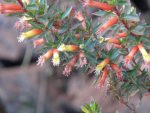 Native to Mexico, this tender evergreen or deciduous perennial shrub is often grown as an annual or houseplant. It is a member of the loosestrife family, Lytharaceae, that also includes crepe myrtle, pomegranate and henna. Plants grow 3-5′ tall from a rhizomatous root system and are densely branched with arching red stems. The 3-6″ long lanceolate leaves are rough textured and have a cream-colored midrib. From late summer to fall 2″ long tubular flowers appear in the upper leaf axils. Each flower consists of fused sepals that emerge yellow but turn orange from the base giving the flower a two-tone appearance. Tiny petals are located on the lip of the tube and long exerted stamens exude a sticky substance. Candy corn plant is the hardiest of the Cupheas and can be grown outdoors in zones 8 and warmer but may die down in the fall in the colder areas. The flowers are attractive to hummingbirds, bees, and butterflies and plants are a good choice for wildlife and butterfly gardens as well as borders, baskets, and containers. Plants can be brought indoors in the fall and overwintered in an area with bright light, temperatures in the 60s, and reduced watering. The genus name, Cuphea, flower comes from the Greek word kyphos meaning curved and refers to the curved seed capsule. The specific epithet, micropetala, comes from the Greek word micros meaning small and the New Latin word petalum meaning petal, and refers to the minute inconspicuous petals of the flowers.
Native to Mexico, this tender evergreen or deciduous perennial shrub is often grown as an annual or houseplant. It is a member of the loosestrife family, Lytharaceae, that also includes crepe myrtle, pomegranate and henna. Plants grow 3-5′ tall from a rhizomatous root system and are densely branched with arching red stems. The 3-6″ long lanceolate leaves are rough textured and have a cream-colored midrib. From late summer to fall 2″ long tubular flowers appear in the upper leaf axils. Each flower consists of fused sepals that emerge yellow but turn orange from the base giving the flower a two-tone appearance. Tiny petals are located on the lip of the tube and long exerted stamens exude a sticky substance. Candy corn plant is the hardiest of the Cupheas and can be grown outdoors in zones 8 and warmer but may die down in the fall in the colder areas. The flowers are attractive to hummingbirds, bees, and butterflies and plants are a good choice for wildlife and butterfly gardens as well as borders, baskets, and containers. Plants can be brought indoors in the fall and overwintered in an area with bright light, temperatures in the 60s, and reduced watering. The genus name, Cuphea, flower comes from the Greek word kyphos meaning curved and refers to the curved seed capsule. The specific epithet, micropetala, comes from the Greek word micros meaning small and the New Latin word petalum meaning petal, and refers to the minute inconspicuous petals of the flowers.
Type: Deciduous or evergreen perennial shrub
Outstanding Feature: Flowers
Form:Rounded
Growth Rate:Rapid
Bloom: Two inch long tubular yellow flowers turning orange from the base and with long exerted stamens exuding a sticky substance; late summer into fall
Size: 3-5′ H x 3’W
Light: Full sun to partial shade
Soil: Average, medium moist, well-drained; somewhat drought tolerant once established
Hardiness: Zones 8-11 (but dies back in colder areas of this range)
Care: Cut back hard in late winter or early spring to encourage bushiness.
Pests and Diseases: None of significance but whiteflies, aphids and root rot can be problems.
Propagation: Seed, cuttings, division